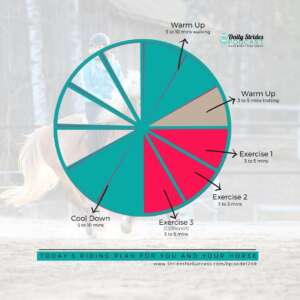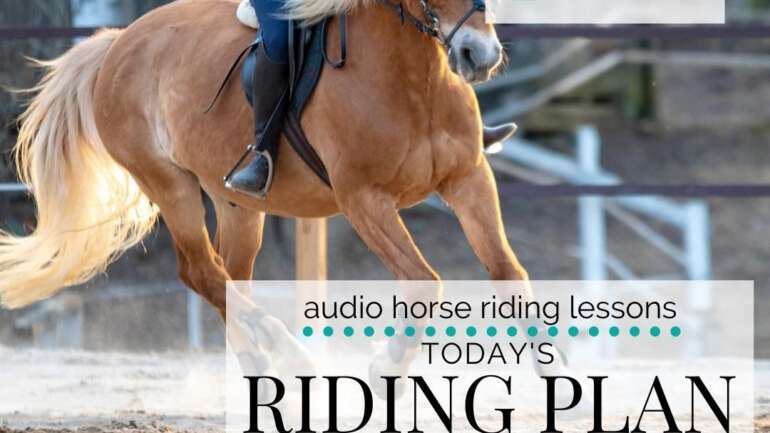“So, what are you planning on doing today?”. It’s a question I ask at least 5 or 6 times a week to different riders. And, let’s be honest here, so often the answer is not all that great! “I’m not sure. We’ll see when we start working.” If that’s you right regarding your next ride with your horse, I am giving you ‘the look’! The look I reserve for riders who say they want to achieve and do all of the things… But they continue to wing it when it comes to their training and their responsibilities as the trainer for their horse.
So, rather than just moan, I am going to give you a step-by-step riding plan today that you can follow so you can truly make the most of your next ride with your horse :)
1. Pick a Filter While Tacking Up
Now, this may seem a little random, but if this plan is going to work and actually help you and your horse in your riding, you MUST do this part. So, what’s a filter? This is the overall theme or intention for your session together. There are many things that this could be, it will really depend on where you are in your training and what you and your horse need right now.
A few examples of ‘filters’ for your riding are:-
-
-
-
- establishing and maintaining correct relaxation throughout
- developing suppleness through staying ‘on track’ (no falling in or out)
- increasing responsiveness to a split second (I ask, and she/he responds appropriately)
- improving accuracy in the timing of my aids
- refining my aids so all become more subtle
- cleaner transitions
- maintaining rhythm before and after transitions
- improving self-carriage and better contact
-
-
The list is endless as to what you want to focus on. However, it is absolutely essential that you choose something to focus on. Otherwise, you will just be riding through the motions aimlessly.
2. Riding Plan; Minutes 0 – 10
This is the warm-up. If you’re really keen to improve things, you will actually have completed a quick ‘stretch’ of your own body BEFORE jumping into the saddle. But, either way, the goal for the first 5 to 10 minutes is to get the blood flowing in your horse’s body and your body.
How long you spend warming up will depend on your situation. Some horses need longer and this will depend on many factors. When in doubt, go longer!
While warming up, use the time to begin ‘syncing’ your movements to your horse. Focus on identifying when each of your horse’s hind legs is moving, and where, and notice how this feels in your seat. This will become very important later.
Also, work on moving forward and, during the second half of this warm-up, begin ‘fine-tuning’ the responsiveness between you and your horse.
For this warm-up I suggest:-
-
-
-
- Walk 2 circuits of the arena on the left rein
- Walk 2 circuits of the arena on the right rein
- 20m circle – x2 in the walk on the left rein
- 20m circle – x2 in the walk on the right rein
- BEGIN PICKING UP MORE CONTACT WITH YOUR HORSE
- Walk a figure of 8
- Go large again on the left rein
- Walk to halt to walk transitions (10 strides walk to 3 seconds of halt)
- Change rein across long diagonal
- Again, walk to halt to walk transitions (10 strides walk to 3 seconds of halt)
-
-
3. Riding Plan; Minutes 10 to 15
From here, in your riding plan, you can begin to work in trot. I always like to start off in the rising trot (posting to the trot). I feel that it gives both horse and rider more of an opportunity to warm up and begin working together. Focus on both your rise and your ‘fall’ (the ups and the downs).
When in the rising trot, keep the idea in your head that you are ‘creating space’ under your backside and saddle for your horse’s back to move into. Keep your movements as light as you can…
Also, remember to keep the energy and thinking moving forwards. Rather have things a little ‘sloppy’ initially but with the energy of ‘forward’ and then tidy it up later as you really begin to engage and work. Looking for everything to be polished from the start often leads to the energy becoming ‘stuck’.
So, in rising trot, you can ride a:-
-
-
-
- 20m circle x3 on the left rein
- go large on the left rein
- change rein across the long diagonal
- on the right rein ride the short side and up the long side of your arena
- 20m circle x3 on the right rein
- go large and then at A or C begin a three-looped serpentine
- on completion go large
- change rein across the long diagonal
- track large on the left rein
- at A or C ride three looped serpentine
-
-
4. Riding Plan:- Minutes 20 to 30 (or 35)
Once you are warmed up, this is where you can begin to transition into the ‘work’ part of the session. This is where you will ask specific questions, and look at what happens as it relates to your theme or focus for the ride.
So, for example, if the focus was on maintaining rhythm before and after transitions, you can begin asking for intentional transitions between trot and walk, walk and halt, halt and walk, walk and trot, and trot and canter. By working up and down the scale between the different ‘gears’ with a specific focus on maintaining rhythm, you will work on improving each transition you ride or ask for.
I suggest keeping the exercises as simple as you can; rather let the focus be on the quality of the work. I also think 2 to 3 different exercises are more than enough during this part of the training.
So, you could ride the previous ‘layout’ again, but this time adding transitions or lateral work, or whatever movements you feel will help you reach your intended outcome or goal. The key is having something planned BEFORE you reach this part of the work. By building to something intentional, you will be more inclined to use the warm-up as a base.
Remember, there shouldn’t be a marked difference between ‘end of warm-up’ and ‘start of training’. They should just blend together and flow from one into the other.
So my suggestion for this part of the ride are:-
-
-
-
- 3 to 5 minutes on exercise 1
- A short break for you and your horse
- 3 to 5 minutes on exercise 2
- A short break for you and your horse
- 3 to 5 minutes on exercise 3
-
-
5. Riding Plan:- Minutes 35 – 45
This is where you transition into the cool-down period. Now, sometimes, depending on what you are working on, there may be a very definite ‘stop work’ part of your ride. This often happens if you have been jumping. You will ride the final exercise, grid, or track, and then finish ‘working’.
However, if you are working on flatwork, you can actually make more of a gradual transition into the cool down and ask for more stretching from your horse. Many riders will associate this type of transition with working ‘long and low’. That is also okay. And remember, just like when you were warming up in the trot, think about allowing ‘space’ for your horses back underneath you.
During the cool-down, you may find that moving out of the arena can help your horse to mentally ‘finish up working’. This can also be helpful for the rider.
Regardless of what you choose to do, the goal here is for your horse’s heart rate to return to normal and for him to stretch things out a little. I also find that this is a great time for the rider to reflect on the training session and make mental notes of what was important. Of course, all of this information will then be recorded in their riding journal… Nudge nudge!

Adapting This for Your Horse
Now, obviously, this plan must be adapted for your horse and the level of training he is comfortable with. This plan assumes that your horse already has achieved a certain level of fitness and is working at a certain level in his training. Unfit or very young/green horses should not be worked for long periods; slow and steady wins.
Using this basic riding plan, you can begin to tweak it as needed so that you have a clear focus for working with your horse. It will allow you to focus on the quality of the work, rather than worrying about what you have to do!
Make sure you record how it went so that you can begin to see patterns over time. This will further help you to discover what works for your horse – and you. You will also begin to see what needs to change regarding your training sessions.
Happy Riding
Lorna

